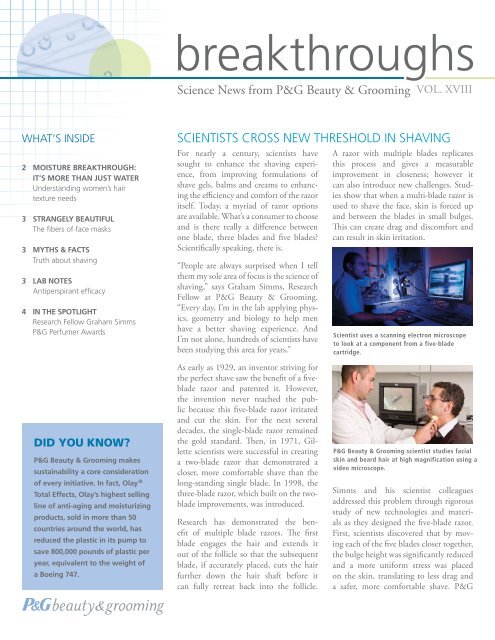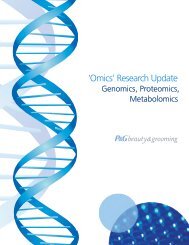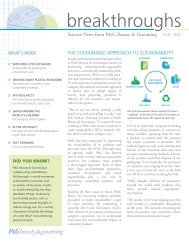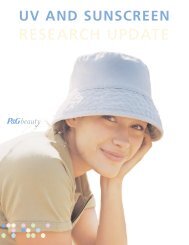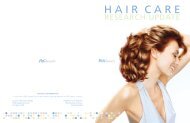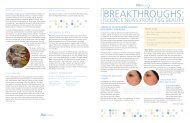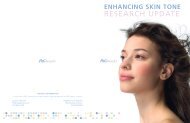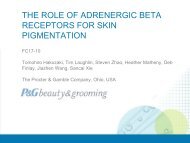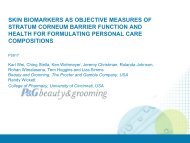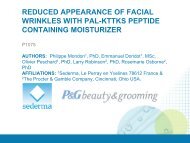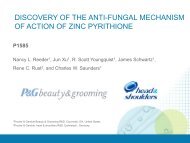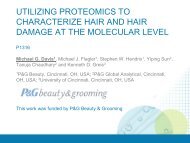breakthroughs - P&G Beauty & Grooming | Error Page
breakthroughs - P&G Beauty & Grooming | Error Page
breakthroughs - P&G Beauty & Grooming | Error Page
You also want an ePaper? Increase the reach of your titles
YUMPU automatically turns print PDFs into web optimized ePapers that Google loves.
eakthroughs<br />
Science News from P&G <strong>Beauty</strong> & <strong>Grooming</strong> VOL. XVIII<br />
WHAT’S INSIDE<br />
2 MOISTURE BREAKTHROUGH:<br />
IT’S MORE THAN JUST WATER<br />
Understanding women’s hair<br />
texture needs<br />
3 STRANGELY BEAUTIFUL<br />
The fibers of face masks<br />
3 MYTHS & FACTS<br />
Truth about shaving<br />
3 LAB NOTES<br />
Antiperspirant efficacy<br />
4 IN THE SPOTLIGHT<br />
Research Fellow Graham Simms<br />
P&G Perfumer Awards<br />
DID YOU KNOW?<br />
P&G <strong>Beauty</strong> & <strong>Grooming</strong> makes<br />
sustainability a core consideration<br />
of every initiative. In fact, Olay ®<br />
Total Effects, Olay’s highest selling<br />
line of anti-aging and moisturizing<br />
products, sold in more than 50<br />
countries around the world, has<br />
reduced the plastic in its pump to<br />
save 800,000 pounds of plastic per<br />
year, equivalent to the weight of<br />
a Boeing 747.<br />
SCIENTISTS CROSS NEW THRESHOLD IN SHAVING<br />
For nearly a century, scientists have<br />
sought to enhance the shaving experience,<br />
from improving formulations of<br />
shave gels, balms and creams to enhancing<br />
the efficiency and comfort of the razor<br />
itself. Today, a myriad of razor options<br />
are available. What’s a consumer to choose<br />
and is there really a difference between<br />
one blade, three blades and five blades?<br />
Scientifically speaking, there is.<br />
“People are always surprised when I tell<br />
them my sole area of focus is the science of<br />
shaving,” says Graham Simms, Research<br />
Fellow at P&G <strong>Beauty</strong> & <strong>Grooming</strong>.<br />
“Every day, I’m in the lab applying physics,<br />
geometry and biology to help men<br />
have a better shaving experience. And<br />
I’m not alone, hundreds of scientists have<br />
been studying this area for years.”<br />
As early as 1929, an inventor striving for<br />
the perfect shave saw the benefit of a fiveblade<br />
razor and patented it. However,<br />
the invention never reached the public<br />
because this five-blade razor irritated<br />
and cut the skin. For the next several<br />
decades, the single-blade razor remained<br />
the gold standard. Then, in 1971, Gillette<br />
scientists were successful in creating<br />
a two-blade razor that demonstrated a<br />
closer, more comfortable shave than the<br />
long-standing single blade. In 1998, the<br />
three-blade razor, which built on the twoblade<br />
improvements, was introduced.<br />
Research has demonstrated the benefit<br />
of multiple blade razors. The first<br />
blade engages the hair and extends it<br />
out of the follicle so that the subsequent<br />
blade, if accurately placed, cuts the hair<br />
further down the hair shaft before it<br />
can fully retreat back into the follicle.<br />
A razor with multiple blades replicates<br />
this process and gives a measurable<br />
improvement in closeness; however it<br />
can also introduce new challenges. Studies<br />
show that when a multi-blade razor is<br />
used to shave the face, skin is forced up<br />
and between the blades in small bulges.<br />
This can create drag and discomfort and<br />
can result in skin irritation.<br />
Scientist uses a scanning electron microscope<br />
to look at a component from a five-blade<br />
cartridge.<br />
P&G <strong>Beauty</strong> & <strong>Grooming</strong> scientist studies facial<br />
skin and beard hair at high magnification using a<br />
video microscope.<br />
Simms and his scientist colleagues<br />
addressed this problem through rigorous<br />
study of new technologies and materials<br />
as they designed the five-blade razor.<br />
First, scientists discovered that by moving<br />
each of the five blades closer together,<br />
the bulge height was significantly reduced<br />
and a more uniform stress was placed<br />
on the skin, translating to less drag and<br />
a safer, more comfortable shave. P&G
eakthroughs: Science News from P&G <strong>Beauty</strong> & <strong>Grooming</strong><br />
<strong>Beauty</strong> & <strong>Grooming</strong> scientists also sought<br />
material improvements on the stainless<br />
steel blades. These blades, that are sharper<br />
than a scalpel, are enhanced with a<br />
diamond-like carbon coating and a<br />
telomer anti-friction layer, which dramatically<br />
enhance the blade’s performance<br />
with less tugging and more comfort.<br />
But scientists still had one more hurdle.<br />
While the closely-packed blades provided<br />
an improved shave, they also caused the<br />
razors to clog easily. Simms and his colleagues<br />
solved this last problem with<br />
narrower blade supports. By thinning<br />
the material under the blades, they<br />
allow more room for shave gel and hair to<br />
be washed away.<br />
Through decades of scientific study and<br />
experience, P&G <strong>Beauty</strong> & <strong>Grooming</strong><br />
scientists have made a 1929 inventor’s<br />
dream of the five-blade razor a reality.<br />
“We were able to apply years of incremental<br />
advances, and multiple disciplines<br />
of study to make this come to life,” says<br />
Simms. “I felt as much like a detective<br />
solving a complex problem as I did<br />
a scientist as we were creating this latest<br />
advance. I’m eager to be presented with<br />
the next problem to solve.”<br />
Scanning electron micrograph of beard stubble<br />
emerging from the irregular skin surface of a<br />
man’s face.<br />
MOISTURE BREAKTHROUGH: IT’S MORE THAN JUST WATER<br />
Many women are looking for ways to<br />
make their hair feel more moisturized.<br />
However, hair with high moisture content<br />
can actually lead to a “bad hair” day. Scientists<br />
have observed that moisture increases<br />
friction between hair fibers and decreases<br />
tensile strength, which leads to an increase<br />
in hair frizz and styling difficulties.<br />
P&G <strong>Beauty</strong> & <strong>Grooming</strong> scientists conducted<br />
an experiment to understand the<br />
meaning of “moisturized” hair, as defined<br />
by women. Specifically, blindfolded panelists<br />
were asked to assess their perception<br />
of “moisture” in two hair samples.<br />
One sample was equilibrated at 15 percent<br />
relative humidity (RH) and the<br />
other was equilibrated at 80 percent RH.<br />
Seventy-five percent of the panelists characterized<br />
the 15 percent RH hair samples<br />
as feeling more moisturized, smoother,<br />
less tangled and less damaged, while less<br />
than ten percent found no difference<br />
between the samples.<br />
A novel microwave resonance measurement<br />
determined the actual water content<br />
of each sample. This assessment<br />
verified that the water level of the 80 percent<br />
RH sample was significantly higher<br />
than that of the 15 percent RH sample,<br />
which sharply contrasts with the panelists’<br />
sensory assessment of “moisture.”<br />
These findings, presented at the 2008<br />
Asian Dermatological Congress, allowed<br />
P&G <strong>Beauty</strong> & <strong>Grooming</strong> scientists<br />
to confirm that “moisturization”<br />
correlates with tactile characteristics such<br />
as smoothness, degree of tangling and hair<br />
damage, rather than actual water content.<br />
“These findings allow us to better<br />
target women’s hair care needs,” explains<br />
Michael Davis, P&G <strong>Beauty</strong> & <strong>Grooming</strong><br />
Senior Scientist.<br />
A second sensory experiment performed<br />
by P&G <strong>Beauty</strong> & <strong>Grooming</strong> has helped<br />
women understand how to achieve the<br />
desired feeling of “moisturized” hair. The<br />
panelists felt two damaged hair samples,<br />
one treated with shampoo and another<br />
treated with shampoo and a conditioner<br />
containing bis-aminopropyl dimethicone,<br />
a modified silicone conditioning agent.<br />
Panelists determined the hair treated with<br />
both shampoo and conditioner felt more<br />
“moisturized.” “These findings are significant<br />
steps toward dispelling the myth of<br />
‘moisturized’ hair,” says Davis. “By educating<br />
women about the importance of<br />
conditioning, we will empower them to<br />
get the hair texture they want.”<br />
% Response<br />
% Response<br />
100<br />
80<br />
60<br />
40<br />
20<br />
0<br />
100<br />
80<br />
60<br />
40<br />
20<br />
Relationship Between Moisture and Perceived Hair Attributes<br />
15% Relative Humidity<br />
80% Relative Humidity<br />
No Difference<br />
More “Moisturized”<br />
Smoother More Tangled More Damaged<br />
Relationship Between Hair Conditioning and Perceived Hair Attributes<br />
Shampoo<br />
Shampoo & Conditioner<br />
No Difference<br />
0<br />
More “Moisturized”<br />
Smoother More Tangled More Damaged<br />
2
STRANGELY BEAUTIFUL<br />
Massage, whether it is gentle stroking or<br />
strong kneading, is recognized as one of the<br />
oldest methods of healing. P&G <strong>Beauty</strong><br />
& <strong>Grooming</strong> scientists have developed<br />
a technology for facial masks that builds on<br />
the fundamentals of massage. The unique<br />
technology uses a stretchable underlying<br />
layer, or substrate, to apply a gentle,<br />
massage-like pressure to the face.<br />
The mask’s special substrate is enhanced<br />
with “splitable fibers” that increase coverage<br />
on the uneven surface of the face.<br />
These fibers (pictured directly below) are<br />
designed to disentangle more easily than<br />
traditional masks, creating a contoured<br />
face mask. This superior fit enhances blood<br />
circulation and allows the ingredients in<br />
the mask to penetrate deep within the skin.<br />
Traditional masks are constructed with a<br />
non-stretchable fiber, such as cotton or<br />
rayon. The non-stretchable fiber (pictured<br />
directly below) is highly tangled, limiting<br />
the mask’s elasticity and ultimately its<br />
ability to fit the face.<br />
The snug fit of “splitable fibers” provides<br />
the full coverage necessary for noticeable<br />
skin benefits.<br />
MYTHS & FACTS<br />
Shaving makes hair grow back thicker.<br />
MYTH: Shaving does not change hair texture.<br />
P&G <strong>Beauty</strong> & <strong>Grooming</strong> scientists<br />
have found that shaving does not cause<br />
hair to grow back thicker, darker or faster.<br />
However, when a shaved hair begins to<br />
re-grow, the tip shape is different from an<br />
unshaven hair. This changes how the hair<br />
feels initially, but if left to re-grow completely,<br />
it will return to its former texture.<br />
The shave gel and the razor are essential<br />
partners.<br />
FACT: Through years of shaving research,<br />
P&G <strong>Beauty</strong> & <strong>Grooming</strong> scientists have<br />
learned that the ideal complement to a<br />
state-of-the-art razor is the right shaving<br />
gel. It allows sharp blades to cut close<br />
while minimizing the risk of irritation by<br />
providing a protective anti-friction layer.<br />
Quality shave gels contain advanced lubricants<br />
to enhance razor glide from the first<br />
stroke to the last and help protect against<br />
nicks, redness and tightness.<br />
LAB NOTES<br />
Antiperspirant Delivers Prescription-Strength Wetness Efficacy<br />
Without Severe Irritation<br />
Often prescription-strength<br />
(Rx) antiperspirants are<br />
recommended for patients<br />
with severe perspiration.<br />
Though efficacious, these<br />
products with aluminum<br />
chloride can irritate the skin<br />
forcing patients to discontinue<br />
use.<br />
Remaining Sweat (mg)<br />
250<br />
200<br />
150<br />
100<br />
50<br />
0<br />
Sweat Remaining After Evening Antiperspirant Application<br />
OTC-Men<br />
OTC-Women<br />
Rx-Women<br />
P&G <strong>Beauty</strong> & <strong>Grooming</strong><br />
scientists addressed this issue by studying perspiration and skin irritation when<br />
using a new (or specially formulated) over-the-counter (OTC) antiperspirant or a<br />
prescription-strength wetness protection product.<br />
Clinical trials were conducted to compare the underarm performance of a “soft<br />
solid” OTC antiperspirant (containing 20 percent aluminum zirconium trichlorohydrex<br />
gly) with a prescription-strength antiperspirant (containing 6.25 percent active aluminum<br />
chloride). Every evening for ten nights, male panelists applied 0.6g of product<br />
and females applied 0.4g of product. A qualified clinician assessed skin irritation<br />
among female panelists. Researchers quantified underarm sweat from all panelists<br />
on days seven and ten.<br />
Data from these trials, presented at the 2007 and 2008 American Academy of<br />
Dermatology conferences, demonstrate similar efficacy for the OTC antipers pirant as<br />
compared to the tested Rx product containing 6.25 percent active aluminum chloride.<br />
However, clinician assessments suggest the OTC antiperspirant delivers this efficacy<br />
with significantly less skin irritation.<br />
Rx-Men<br />
Day 7<br />
Day 9<br />
3
eakthroughs: Science News from P&G <strong>Beauty</strong> & <strong>Grooming</strong><br />
IN THE SPOTLIGHT<br />
Graham Simms, Research Fellow<br />
P&G <strong>Beauty</strong> & <strong>Grooming</strong><br />
recruits experts with<br />
diverse specialities to<br />
develop the most<br />
advanced and effective<br />
shaving technologies.<br />
Graham Simms,<br />
Research Fellow at the<br />
Gillette Technology Centre in Reading,<br />
U.K., is a Chartered Mechanical<br />
Engineer who has worked in the<br />
<strong>Grooming</strong> division for 19 years.<br />
His reputation for being an enthusiastic<br />
innovator is bolstered by the fact<br />
that 17 patents, ranging from razors to<br />
writing instruments, carry his name.<br />
He has made significant contributions to<br />
the development of many system razors<br />
such as Venus Divine and M3Power.<br />
Simms created the Future Technologies<br />
department at Reading to scout the world<br />
for novel technologies that could be used<br />
in new razor prototypes. He also led the<br />
multi-disciplinary Concept Engineering<br />
Team that overcame tough technical challenges<br />
to make five-blade razors a reality.<br />
Prior to joining P&G <strong>Beauty</strong> & <strong>Grooming</strong>,<br />
Simms worked at British Aerospace<br />
and invented navigation systems for military<br />
aircrafts, ships and missiles. “I moved<br />
from designing products that I hoped<br />
people would never use,” notes Simms, “to<br />
designing products that I hope consumers<br />
will use every day.”<br />
Acclaim for P&G Perfumers<br />
At the 2008 annual meeting of the American<br />
Society of Perfumers, P&G perfumers<br />
were awarded nine Perfumer Choice<br />
Awards for best in-market fragrances. In<br />
the 20 year history of these awards, no<br />
company has ever swept more than a third<br />
of the awards in a single year—until now.<br />
More than 200 perfumer peers chose the<br />
winners based on a blind sampling of<br />
products in 25 categories. Of the nine<br />
awards received by P&G, four awards were<br />
for products in beauty care categories. Zerlina<br />
Dubois and Stacy Hertenstein, P&G<br />
<strong>Beauty</strong> & <strong>Grooming</strong> perfumers, accepted<br />
the awards.<br />
The following coveted awards recognize<br />
the superior fragrance science and design<br />
that P&G <strong>Beauty</strong> & <strong>Grooming</strong> provides<br />
to the world’s consumers every day:<br />
Best Hair Care Fragrance Mass<br />
Pantene® Pro-V Color Expressions<br />
Shampoo<br />
Best Body Care Fragrance Women’s<br />
Secret® Clinical Light & Fresh Scent<br />
Best Body Care Fragrance Men’s<br />
Old Spice® After Hours Deodorant<br />
Best Fragrance Line Extension Specialty<br />
The Herbal Essence® Series<br />
Resources<br />
http://www.aad.org/<br />
(American Academy of Dermatology)<br />
http://www.perfumers.org/<br />
(American Society of Perfumers)<br />
http://www.adc2008.org/<br />
(Eighth Asian Dermatological Congress)<br />
P&G <strong>Beauty</strong> & <strong>Grooming</strong> Science has more than 1,800 scientists and technical employees working at nine<br />
global technical centers with an unparalleled commitment to technology development. Company scientific<br />
efforts have resulted in over 10,000 patents. This allows P&G to develop products uniquely suited for different<br />
types of hair and skin, and tailored to different cultures and climates.<br />
P&G <strong>Beauty</strong> & <strong>Grooming</strong> products help make beauty dreams real for women worldwide and help men look,<br />
feel and be their best every day. With more than 100 brands available in nearly 130 countries, P&G’s beauty and<br />
grooming products delivered sales of nearly $28 billion in fiscal year 2007/08 , making it one of the world’s largest<br />
beauty and grooming companies. P&G <strong>Beauty</strong> & <strong>Grooming</strong> offers trusted brands with leading technology to<br />
meet the full complement of beauty and grooming needs, including Pantene®, Olay®, Head & Shoulders®, Max<br />
Factor®, Cover Girl®, DDF®, Frederic Fekkai®, Wellaflex®, Rejoice®, Sebastian Professional®, Herbal Essences®,<br />
Koleston®, Clairol Professional®, Nice ’n Easy®, Venus®, Gillette®, SK-II®, Wella Professionals®, Braun® and<br />
a leading Prestige Fragrance division that spans from point of market entry consumers to high end luxury with<br />
global brands such as Hugo Boss®, Lacoste®, and Christina Aguilera®. (NYSE: PG)<br />
Please visit www.pgbeautyscience.com for the latest news and in-depth information<br />
about P&G <strong>Beauty</strong> & <strong>Grooming</strong> and its scientific developments.<br />
To talk to a P&G <strong>Beauty</strong> & <strong>Grooming</strong> scientist<br />
or to learn more about ongoing research<br />
at P&G <strong>Beauty</strong> & <strong>Grooming</strong> Science, contact:<br />
Heather Cunningham<br />
P&G <strong>Beauty</strong> & <strong>Grooming</strong> Science<br />
+513-626-2606<br />
4


